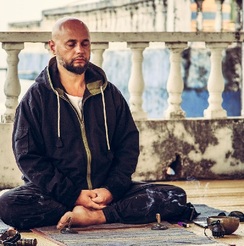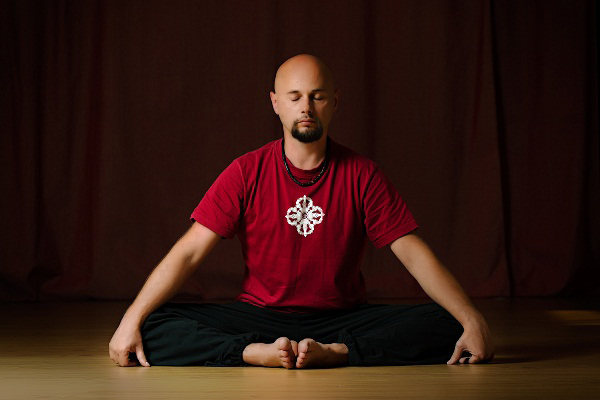Interview with Anatoliy Pakhomov: on correct approach to the spine, freedom, and meditation

Journalists of TopYogis are traveling in different countries around the world to discover outstanding yoga teachers and unique styles of yoga. We had the chance to talk with some of these teachers.
This is a translation of the interview with Antoliy Pakhomov, a founder of Vajra Yoga style that is quite popular in Ukraine, Russia and spreads into other countries. The style is interesting due to its particular attention to meditational practices (especially meditation of self-observation, Mahamudra) and correct approach to the spine in physical practices. We talked with Anatoliy about what is the most important in the practice of yoga.
TopYogis: Anatoliy, what is the purpose of yoga for you?
Anatoliy Pakhomov: It is getting to know one’s own nature so that one could find an inner strength to overcome difficulties presented by life. Also, in our school, we pay a lot of attention to the principle of freedom. As you could notice in the class, we do not make people perform exercises that they don’t like. They are free to do what is comfortable for them. All people are different. We all have different bodies, different injuries, and different goals in yoga. And yoga is a multifaceted instrument, it can provide tools for various goals.
Also, in Vajra yoga, we treat the physical body with great caution. This approach was developed on the basis of my own experience, and also thanks to my teacher, who taught me the correct approach to the spine.
The purpose of yoga is getting to know one’s own nature so that one could find an inner strength to overcome difficulties presented by life.
Therefore one could say that all styles of yoga have a goal of realizing of human potential, but many of them practice injury-prone exercises. Especially since late 19 - early 20th century, when yoga started to be promoted as a type of gymnastics. I, to the contrary, want yoga to go back to its ancient sources: the practice of meditation, Mahamudra. Asanas too, of course, as we all have bodies and we should work on them, but physical component should not be a priority in the discipline of yoga. The problem with modern styles of yoga is in the high rate of injuries. I know people, who having experienced yoga-related injuries, abandon yoga. They think that they are not fit for yoga. And it’s sad, as they have not been shown yoga’s full potential of calming down the mind and tuning down all internal struggles.
In Vajra yoga, we pay a lot of attention to the principle of freedom. As you could notice in the class, we do not make people perform exercises that they don’t like. They are free to do what is comfortable for them.
TopYogis: So how do you choose the asanas that you teach in the class?
Anatoliy Pakhomov: The sequence has been formed over many years as a result of observation of myself and people who practice in my class. I now believe that the instructor should give the same sequence in each class. My sequence has been developed over the years and it works for me. First, practicing the same sequence every time is good for safety: you’re doing habitual exercises. And second, habitual exercise means that the body gets ready for it biochemically. If the body knows what to expect from tomorrow’s class, it prepares necessary biochemicals to deal with the challenge. That’s why, within last 10 years of teaching, I have come to the conclusion that teaching one sequence in every class is better for people.
The problem with modern styles of yoga is in the high rate of injuries. I know people, who having experienced yoga-related injuries, abandon yoga. They think that they are not fit for yoga. And it’s sad, as they have not been shown yoga’s full potential of calming down the mind and tuning down all internal struggles.
TopYogis: Do all instructors in your school teach the same sequence?
Anatoliy Pakhomov: Well, I tell them that the best way is to take a sequence that works and to teach it. But every instructor has the freedom to modify it according to their own likings and feedbacks from people in their class.
TopYogis: Let’s say, somebody has only 15 minutes for a daily practice. What are the most important things that you would recommend them to do within these 15 minutes?
Anatoliy Pakhomov: First of all, I do not understand why they would have only 15 minutes for practice. I think they don’t know the meditation of Mahamudra yet. Because once they know it, they would understand that they can meditate while working, eating, while commuting. I am talking to you and I am practicing at the same time.
TopYogis: So you would say, the most important is to practice Mahamudra?
Anatoliy Pakhomov: On the mental level, yes. And on the physical level, the most important thing is to know how to work with the body correctly. The thing is, if you injure your body, you will not be able to continue your practice. I have seen it many times. That’s why it’s very important to work with your body correctly. And more specifically, to work with the spine, as it is a vital organ that contains and protects our peripheral nervous system. We want to keep it healthy and functional. Unfortunately, many yoga schools teach things that have never been practiced in classical yoga. And what’s worse, these things are wrong from the biomechanics point of view.
On the mental level, the most important practice is Mahamudra. But on the physical level, it's important to work with your body correctly. And more specifically, to work with the spine, as it is a vital organ that contains and protects our peripheral nervous system.
TopYogis: What practices do you avoid in your school?
Anatoliy Pakhomov: We do not do spinal twists, lateral bends, deep forward and backward bends that take the spine beyond the natural range of motion. We do not give inversions like handstands, in a group practice. If you practice yoga from the early age, at least from 15 years old, like I did, your bones will adapt to the stress that you induce on them with the inversions. But bones stop growing at the age of 22 years. If a grown up person who has never practiced yoga starts to do inversions, their bones structure will not support the load. Yes, one can develop the muscles, but the bones need to be conditioned as well. This happens only if you practice since an early age. That’s why we do not give inverted postures in our group practice.
When my teachers taught me the principles of biomechanics, I started to reform my practice to make it safe and accessible to everyone. And what I came to, is to ancient yoga: minimum of movements, few asanas, and no acrobatics.
TopYogis: What I have noticed is that I feel no tiredness after your class.
Anatoliy Pakhomov: That’s how it’s supposed to be. If you’re crawling out from a yoga class, you have given your body too much stress. You should walk out the yoga class full of energy and enthusiasm for action. That means you have been practicing yoga correctly. Very often, people go to work after yoga class, they have to take care of their families, other obligations. That’s why we need to make yoga sequences that give them the energy to do all these things. We need to follow a middle way. It’s being forgotten nowadays, unfortunately.
You should walk out the yoga class full of energy and enthusiasm for action. Follow the middle way in your practice and life.
TopYogis: We hope that your approach to yoga will help revive the middle way. Thanks a lot!
If you have practiced with Anatoliy and want to share your experiences, leave a review on his personal page or his school's page.
All instructors of Vajra Yoga around the world.
All yoga teachers in Kyiv (Kiev) - all styles
Find yoga schools and studios in Kyiv
